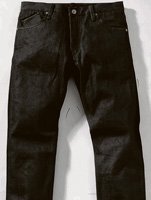Altamont Launches Selvage for Skaters
Altamont, the year-old skate-inspired line of men’s apparel from Lake Forest, Calif.–based Sole Technology, will debut its first collection of selvage denim for Spring 2008. Launched in collaboration with Andrew Reynolds, a particularly dapper skater with an eye for design, Altamont aims to personify skating’s cutting-edge style. “We see a lot of trends start on the street with skaters, and too often those trends get adopted by brands outside the culture and appropriated. We want to capture the trends in an authentic way for ourselves,” said Justin Regan, Altamont’s brand manager.
Denim has always been a big part of the tightly edited brand. With five different denim silhouettes per season in styles ranging from superskinny carrot legs to a relaxed straight-leg fit, Altamont’s denim fills a purpose beyond fashion. “Denim is a staple for us because often jeans are our first layer of protection when we’re skating. They’re like our protective gear,” Regan explained.
The launch of the fivepiece selvage collection is more about fashion than function, though it, like Altamont’s other denim, is imbued with 1 percent stretch so that the wearer can still skate in the jeans. Normally a fixation among denimheads, selvage is something Altamont thinks its customers can get behind. “Older skaters know about selvage. The younger ones really don’t. Luckily for us, our customer is that older skater. He’s 18 to 24, he knows fashion and we don’t really have to educate him about selvage,” Regan said.
Sourced from the Kurabo denim mill in Japan, the selvage jeans feature clean washes, no-frills pockets and selvage denim in bone and deep purple. Wholesaling from $60 to $65, the Altamont selvage is roughly twice the price of the brand’s standard jeans. “It’s a little pricier, but its better-quality denim; it’s more sophisticated.”
Altamont retails at approximately 100 stores, including The Closet, Active, Brooklyn Projects and Beach Bums.
Blue Jeans Insulate Pioneering Museum
The new Academy of Sciences museum, aquarium and research facility, currently being built in San Francisco’s Golden Gate Park, is a study in green architecture. With a living roof of 1.7 million plants that will reduce the need for air conditioning, motorized windows that allow cool breezes in, an innovative design that moves air without the need for costly vents, toilets that use reclaimed water, and saltwater for the aquariums piped in from the ocean, the Academy is packed with the latest eco-friendly technology and techniques. It seems fitting then that one of the innovative, eco-friendly tricks involved blue jeans—which have been identified with San Francisco since Levi Strauss set up shop in the city in 1853.
To protect against the city’s chilly winters and steamy summers, the entire 410,000- square-foot building will be insulated with recycled blue jeans. Made from cutting-room scraps by Chandler, Ariz.–based Bonded Logic, the denim insulation is 85 percent post-industrial-use blue jeans.
“Cotton, which blue jeans are made of, is a rapidly renewable source, and it is a healthier kind of insulation,” said Stephanie Stone, the Academy’s associate director of communications. “It is a noitch product, it doesn’t require the use of masks or gloves during installation and it is mold-resistant.” The recycled jeans are treated to have the same fire-retardant properties as conventional fiberglass insulation. “It’s pretty much the ideal insulation,” Stone said.
The insulation is made in a relatively simple process that involves pulling apart the blue-jean scraps into bales of loose fibers, treatment with a nontoxic borate solution that gives the denim mold-, mildew- and pestresistant properties, and a baking process that helps the denim retain its new shape. Bonded Logic, which markets the denim insulation under the Natural Touch label, says it diverts 200 tons of landfill waste monthly with the product.
More than nine tons of denim scraps were used to insulate the Academy, according to Bonded Logic’s Sean Desmond, the company’s director of sales. “That would make quite a few pairs of jeans,” he quipped.
In the end, when the Academy opens in 2008, the building will consume 30 percent to 35 percent less energy than required by code; create plant habitats for local and endangered birds, insects and animals; and be a well-insulated place for school kids to learn about the environment.























